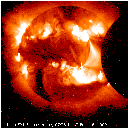| Special show last week: the solar eclipse of Feb. 16! Yohkoh
observed two of the three eclipse episodes this time - we get eclipse opportunities
twice a year, with up to five episodes per eclipse because of the complicated
relative motions of spacecraft, Sun, and Moon. See [1]
[2] [3]
[4] for earlier Yohkoh
views of eclipses. |
 |
In this particular image, you will notice the lunar shadow occulting the
sharply pointed cusp that formed on the solar equator following a major
flare and CME, the first time we've seen this behavior. See the science
nugget below for more information about the remarkable behavior of these
transequatorial magnetic structures - which, our graybeards say, can only
form as a result of magnetic reconnection!
Transequatorial loops, the movie
Science Nugget: Feb 19, 1999
1. Hajime ni
Yohkoh began observing during the declining phase of the past solar
cycle, and now it's observing the rise phase of the next. One of the most
exciting differences in the nature of the data has been the behavior of
the trans-equatorial loops, which appear to connect between independent
active regions in the north and the south. The single best example from
the past maximum was a remarkable quadrupolar feature described in a
1996 paper by S. Tsuneta, but in fact what we describe below looks
quite different from that case.
The items below are just superficial comments on some characteristics
of the loops, with no analysis. The movie is at the end.
2. Ost und West
At the time of writing, the NS structure had not quite arrived at the west
limb. Nevertheless, the comparison of east and west apparitions is neat:
 |
The image at left shows the two limbs of the Sun at a spacing of about
two weeks, to match the solar rotation from limb to limb. At the time of
the east image (left), the transequatorial loops were already well-formed;
our previous real-time glimpse two days earlier did not show them. The
difference of the background levels in these images, incidentally, is due
to imperfect image preparation in these quasi-real-time data reductions. |
3. Eruption Solaire
A remarkable solar flare occurred on February 16, leading to a major CME
and geomagnetic storm. Yohkoh missed the flare itself, but the images
below show that we recorded a remarkable post-flare, and post-CME, phenomenon.
So far as we're aware such a thing has never before been observed in X-rays.
 |
These three images show the X-ray sun before the flare, after it, and
later still. The remarkable feature is the large cusp-shaped structure
pointing to the west (right). This strongly suggests post-CME magnetic
reconnection; the timing implies that the flare caused the CME, opening
the streamer field, which then reconnected in the classical picture. The
very bright flare loops (central panel) presumably have some other explanation
they are not the result of the closing-down of field lines opened in the
eruption. |
4. El Cine
Well, in fact this remarkable structure did several other noteworthy things
as it rotated across the disk, but I don't have time to display them. We
really are seeing some developments ("restructurings") that should help
us to understand the large-scale coronal magnetic field and its basic magnetohydrodynamics.
Somebody should follow through, please, with analyses. Here is a two-week
movie, but please note that it's got major gaps (see the GOES plot above)
since we have only used the real-time data.

Click on the thumbnail to get the GIF version of the movie, but beware
that it's 2.8 MB long. If you're in a bandwidth-challenged domain, the
mpeg version - somewhat more detailed - only
has 404 kB. The movie contains at least three other quite interesting morphological
features: a homologous predecessor of the flare cusp; a ripple effect along
the northern footpoints of the structure, and the 3D form of the lower
boundary. Sorry there is no time to display them properly. See last
week's nugget for links to other related nugget pages.
February 19, 1999: Hugh Hudson (email hudson@isass0.solar.isas.ac.jp;
comments especially welcome from German, French, or Spanish solar physicists
regarding my topic titles!)



